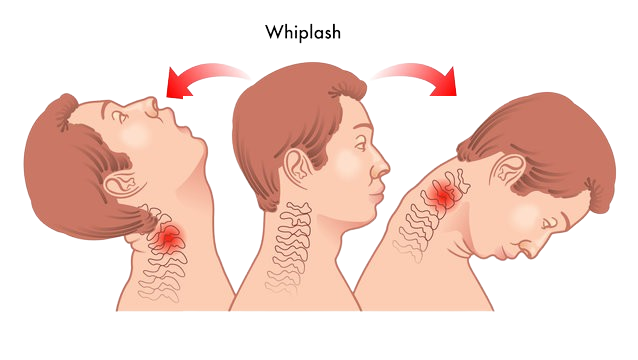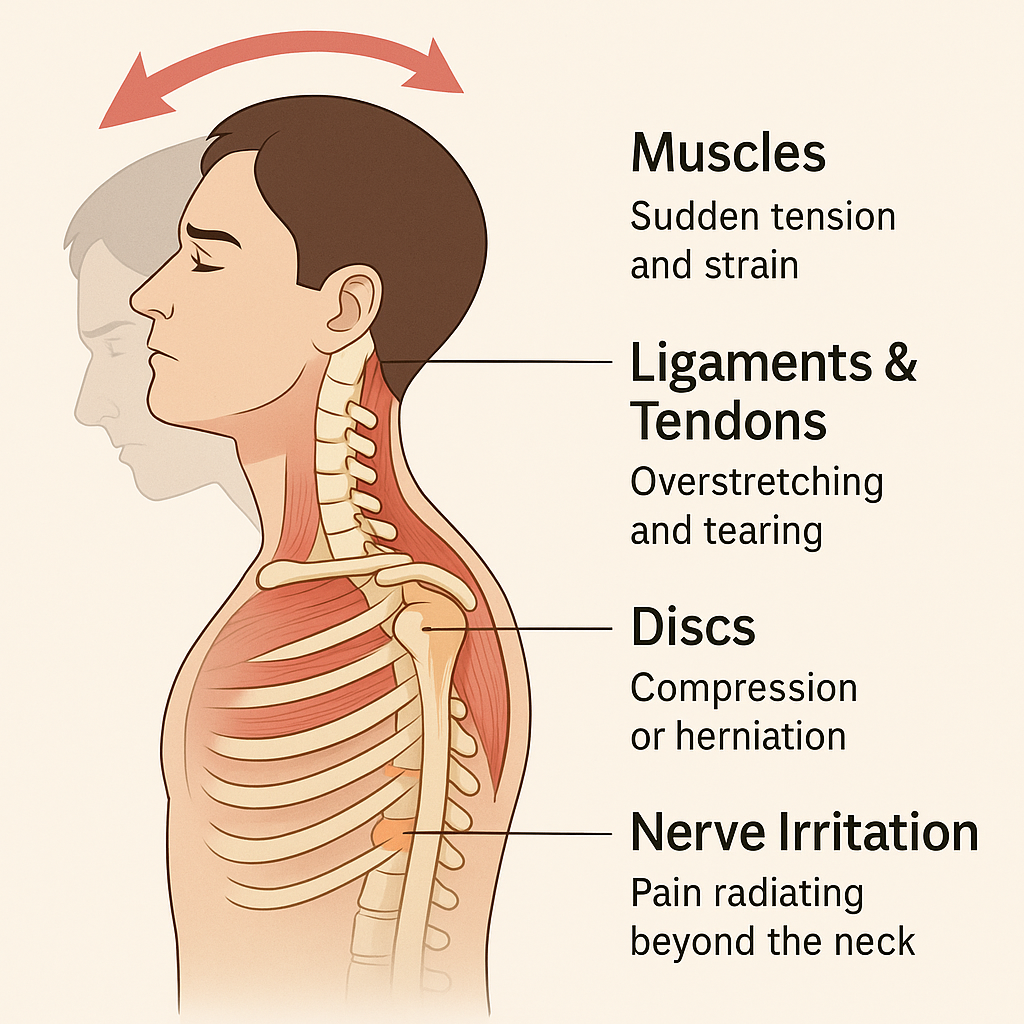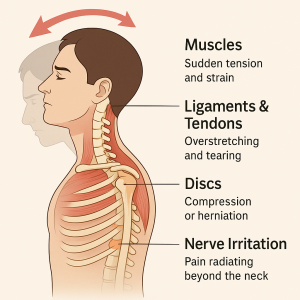Understanding Whiplash: A Realistic Guide to Recovery
Whiplash is more than just a sore neck after a car crash. It’s a complex injury that affects your muscles, ligaments, nervous system and even your emotions. I know, because I’ve been through it.
This guide combines medical knowledge with personal experience to help you better understand your symptoms and start your healing journey.
What Is Whiplash, Really?
Whiplash is commonly understood as a neck injury caused by a sudden and forceful movement of the head, often due to car accidents or similar incidents. But it’s not just about the neck. It’s about how the body responds to a rapid, jarring force that affects not just muscles but ligaments, tendons, and even the nervous system.

Understand your symptoms and where you stand
Practical tips and workouts to help you heal
Understand your symptoms and where you stand
Practical tips and workouts to help you heal
The Anatomy of Whiplash: A Deeper Look
When the head is thrown forward and then back in an accident, it can cause damage to various structures in the neck. This is often due to the overstretching and tearing of tissues that aren’t built to handle such force.
- Muscles: The neck muscles, especially the ones at the front and back of the neck, experience sudden tension and strain. These muscles can be pulled and even develop micro-tears that can take time to heal, leading to chronic pain.
- Ligaments & Tendons: Ligaments hold the bones of the spine together, while tendons connect muscles to bones. Both are vulnerable in a whiplash injury, and damage here can lead to long-term instability in the neck. In severe cases, these tears can be hard to detect immediately but can contribute to long-term pain.
- Discs: The intervertebral discs act as cushions between the bones of the spine. Whiplash can cause compression or even slight herniation of these discs, which may press on nerves and lead to symptoms like numbness or tingling in the arms and hands.
- Nerve Irritation: The sudden motion can irritate or compress nerves, which is why whiplash can sometimes cause radiating pain or symptoms beyond the neck, affecting the arms, back, and even the head (leading to headaches or migraines).

When the head is thrown forward and then back in an accident, it can cause damage to various structures in the neck. This is often due to the overstretching and tearing of tissues that aren’t built to handle such force.
- Muscles: The neck muscles, especially the ones at the front and back of the neck, experience sudden tension and strain. These muscles can be pulled and even develop micro-tears that can take time to heal, leading to chronic pain.
- Ligaments & Tendons: Ligaments hold the bones of the spine together, while tendons connect muscles to bones. Both are vulnerable in a whiplash injury, and damage here can lead to long-term instability in the neck. In severe cases, these tears can be hard to detect immediately but can contribute to long-term pain.
- Discs: The intervertebral discs act as cushions between the bones of the spine. Whiplash can cause compression or even slight herniation of these discs, which may press on nerves and lead to symptoms like numbness or tingling in the arms and hands.
- Nerve Irritation: The sudden motion can irritate or compress nerves, which is why whiplash can sometimes cause radiating pain or symptoms beyond the neck, affecting the arms, back, and even the head (leading to headaches or migraines).

Why Do Symptoms Often Show Up Late?
One of the most frustrating parts of whiplash is that symptoms often don’t show up right away. Many people walk away from a crash or accident thinking they’re fine — only to wake up days (or even weeks) later with pain, stiffness, and brain fog. Here’s why that happens:
Delayed Inflammation
In the immediate aftermath of a whiplash injury, your body may not show signs of damage yet. The inflammatory response, which causes swelling, pain, and stiffness, often takes time to fully develop. What seems like a minor tweak can evolve into significant discomfort over the next few days.
Muscle Overcompensation
After the injury, your body tries to protect the damaged area by shifting movement to surrounding muscles. These compensating muscles may become overworked, tight, or even go into spasm, leading to further pain and dysfunction over time, especially if the original injury isn’t addressed.
Nerve Sensitization
Your nervous system can become more sensitive after trauma. Even a mild injury can lead to what’s known as “central sensitization,” where the nerves amplify pain signals, making normal movements feel painful. This can explain why symptoms worsen or become more widespread with time.
Cognitive and Neurological Effects
Whiplash can affect the brain’s ability to regulate pain and stress.
That’s why many people experience:
• Brain fog
• Sleep disturbances
• Difficulty concentrating
These symptoms may come on gradually and are often overlooked in the early stages.
Emotional Side Effects: Why It’s Not Just Physical
Mind-Body Connection (TMS & Emotional Factors)
Pain isn’t only physical. It’s also emotional and neurological. For some, the initial injury might heal physically, but pain persists due to Tension Myositis Syndrome (TMS) or similar mind-body responses.
Fear of pain, frustration, or anxiety can fuel the pain cycle.
Suppressed emotions, past trauma, or perfectionist tendencies may cause your body to “hold” stress in vulnerable areas like the neck or back.
Your brain may misinterpret emotional or psychological tension as physical danger, causing it to create or amplify pain in an attempt to protect you.
Mood Changes and Anxiety
Living in pain, especially when it’s invisible or misunderstood takes a toll. Many people with whiplash report:
• Irritability
• Depression
• Anxiety
• A sense of hopelessness about recovery
Uncertainty around diagnosis, a lack of visible injury on scans, and fear of not being believed can all deepen this emotional strain.
Pain is Complex and You’re Not Crazy
Just because your pain took time to appear doesn’t mean it’s not real. In fact, delayed onset is very common with injuries involving the nervous system and soft tissues. Understanding the nature of pain is a powerful first step in recovery.
Self-Assessment: Where Are You Now?
Before you begin: This guide is not a substitute for medical advice. Always consult a trained professional first to rule out serious injuries, such as fractures or nerve damage. Once you’ve done that, this self-assessment can help you better understand where your symptoms may be coming from and track changes over time.
Use this as your starting point, like a snapshot of where you are now. Write down what you find, or use the template below to keep track. This will help you monitor progress and spot patterns as you recover.
1. Range of Motion & Joint Stiffness
How to check:
Gently turn your head left, right, up, and down.
Tilt your head from one shoulder to the other.
Move slowly. Stop if anything causes sharp pain.
What to look for:
Are some movements limited or blocked?
Do you feel tightness or pulling?
Are there clicking or cracking sounds?
In my case, I noticed that I have limited range of motion when looking to the left. I also get cracking sounds when I move my neck some days, which can feel worrying. But it usually means there’s tightness or joint pressure, not something dangerous.

Which movements feel restricted
Where you feel stiffness
Any sounds (clicking, popping, grinding) and whether they hurt
2. Muscle Tension & Sore Spots
How to check:
Use your fingers to gently press on different areas around your neck, shoulders, and upper back.
Press under your skull, just behind your ears.
Check for soreness, tightness, or tension.
What to look for:
Are certain spots painful or tender to the touch?
Do the muscles feel hard, knotted, or reactive?
Personally, I found that the area just under the skull where the neck meets the base of the head is stiff on both sides. I also feel a sore spot left of the spine, and I have pain when pressing on some of the bony points in my neck and shoulder.

Where you feel the most tension or pain
If the muscles feel “locked” or reactive
Any patterns (e.g. worse after certain activities)
3. Nerve Involvement (If Present)
How to check:
Notice whether you ever feel tingling, numbness, or electric-shock-like sensations in your arms, fingers, or shoulders.
What to look for:
Do these sensations increase with neck movement or certain positions?
Do you feel weakness in your grip or arm strength?
I personally didn’t experience any tingling or numbness, which is usually a good sign that the nerves weren’t directly involved in my case.

Any signs of nerve-like sensations (if present)
If movement triggers those feelings
Any changes in strength or coordination
Practical Tools That Helped Me The Most
I know all of this can feel really overwhelming at first. You might be tempted to try everything at once I’ve been there. But if you’re anything like me, that only makes it harder to actually start and keep going. So instead, here are some simple, practical steps that helped me the most and can help you get started too.
-
Morning Stretching and Mobility
Starting my day with gentle stretches and mobility exercises helped me wake up my body and reduce stiffness. It sets a positive tone for the day and gradually improved how my neck felt. Click here to find some easy stretches. -
Posture Matters
Pay close attention to your posture throughout the day. Avoid sitting bent over your phone or computer for hours. Keeping your spine aligned and shoulders relaxed can ease a lot of tension in your neck. -
Strengthening Your Neck Muscles
I know your neck probably hurts and you might be scared to move it, worried about making things worse. But starting slowly with gentle strengthening exercises won’t injure you. It actually helps build support around your neck. I have a small daily workout you can do at home, and swimming is another great way to strengthen those muscles gently. Click here for a simple daily workout routine. -
Journaling
At some point, I realized the pain wasn’t just physical—it was taking a huge emotional toll. I felt depressed, anxious, and sometimes like my body had given up on me. Journaling helped me face those feelings, accept them, and slowly find more peace. -
Understanding the Mind-Body Connection
It’s easy to get lost searching the internet for answers, only to find stories that make you feel worse. Instead, I found value in reading about the mind-body philosophy, especially a concept called TMS (Tension Myoneural Syndrome). It explains how pain can sometimes become more psychological after an injury. It’s a tough read, I started the book many times before I actually finished it—but it really changed how I looked at my recovery. If you want, I’ve put together a short summary of TMS here. -
Tracking Your Symptoms
Keep track of how you feel day to day and what activities seem to make things better or worse. This helps you find patterns and understand your body’s limits. -
Talk About It
Don’t keep your feelings and struggles bottled up. Talk to people you trust about how whiplash is affecting your life. If you don’t feel like talking to anyone in person, even just writing down your thoughts or talking to ChatGPT can help. You don’t have to go through this alone.
Quick Summary, What Really Worked
Morning mobility: Gentle stretches to start the day
Posture awareness: Especially at your desk or phone
Gentle strength-building: Swimming and low-impact bodyweight exercises
Journaling: Helped me process emotions and track patterns
Mind-body connection: Learning about TMS changed how I saw my pain
Track your symptoms: Spot patterns, avoid setbacks
You Are Not Alone, Healing Is Possible
I’ve walked this path too, and I know it can be frustrating, lonely, and scary at times. But I promise, you are not alone. There is a way forward, and day by day, you can get better. Recovery isn’t always linear, and it takes time and patience but every small step counts. Keep going. You’ve got this, and I’m here to support you along the way.
For more details on exercises, posture, and other helpful strategies, please visit the Recovery Tools page. You’ll find practical advice and simple guides to support your recovery.
